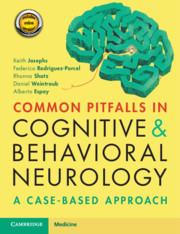Book contents
- Common Pitfalls in Cognitive and Behavioral Neurology
- Common Pitfalls in Cognitive and Behavioral Neurology
- Copyright page
- Dedication
- Contents
- Diseases Discussed in the Book
- Preface
- Acknowledgements
- Abbreviations
- Part 1 Missing the Diagnosis Altogether
- Part 2 Misidentifying the Impaired Cognitive Domain
- Part 3 Missing Important Clues in the History
- Part 4 Failure of Pattern Recognition
- Part 5 Difficult-to-Characterize Cognitive/Behavioral Disorders
- Part 6 Clinical Findings That Are Subtle
- Part 7 Misinterpreting Test Results
- Part 8 Attributing Findings to a Known or Suspected Disorder
- Part 9 Missing Radiographic Clues
- Case 41 Another Case of Vascular Cognitive Impairment?
- Case 42 Pseudoatrophic Pattern in Hydrocephalus
- Case 43 Parkinsonism, Ataxia, and Cognitive Impairment after Radiation Therapy
- Case 44 It’s Not Alzheimer Disease; Now What?
- Case 45 Getting the Full Picture
- Part 10 Management Misadventures
- Index
- Plate Section (PDF Only)
- References
Case 42 - Pseudoatrophic Pattern in Hydrocephalus
from Part 9 - Missing Radiographic Clues
Published online by Cambridge University Press: 03 November 2020
- Common Pitfalls in Cognitive and Behavioral Neurology
- Common Pitfalls in Cognitive and Behavioral Neurology
- Copyright page
- Dedication
- Contents
- Diseases Discussed in the Book
- Preface
- Acknowledgements
- Abbreviations
- Part 1 Missing the Diagnosis Altogether
- Part 2 Misidentifying the Impaired Cognitive Domain
- Part 3 Missing Important Clues in the History
- Part 4 Failure of Pattern Recognition
- Part 5 Difficult-to-Characterize Cognitive/Behavioral Disorders
- Part 6 Clinical Findings That Are Subtle
- Part 7 Misinterpreting Test Results
- Part 8 Attributing Findings to a Known or Suspected Disorder
- Part 9 Missing Radiographic Clues
- Case 41 Another Case of Vascular Cognitive Impairment?
- Case 42 Pseudoatrophic Pattern in Hydrocephalus
- Case 43 Parkinsonism, Ataxia, and Cognitive Impairment after Radiation Therapy
- Case 44 It’s Not Alzheimer Disease; Now What?
- Case 45 Getting the Full Picture
- Part 10 Management Misadventures
- Index
- Plate Section (PDF Only)
- References
Summary
This 77-year-old man presented with a 6-year history of worsening short-term memory and urinary urgency. He first noticed difficulties multitasking and remembering long lists, with significant benefit from cueing. He later noticed word-finding difficulties and would lose track of the topic of conversation. Around that time, he began experiencing worsening urinary urgency, followed by incontinence. Two years prior to his evaluation, his gait became increasingly slower, leading eventually to multiple falls. He also became withdrawn and more irritable. On exam, he exhibited symmetric bradykinesia, rigidity, and postural impairment. His gait was wide based with external rotation of the feet and inability to tandem walk (Video 42.1). His brain MRI was interpreted as showing asymmetric cortical atrophy with asymmetric ventriculomegaly (Image 42.1). Given an ostensible presentation with memory impairment, and suspected atrophy on imaging, Alzheimer disease (AD) was diagnosed and he was started on a treatment trial with donepezil.
Information
- Type
- Chapter
- Information
- Common Pitfalls in Cognitive and Behavioral NeurologyA Case-Based Approach, pp. 133 - 136Publisher: Cambridge University PressPrint publication year: 2020
